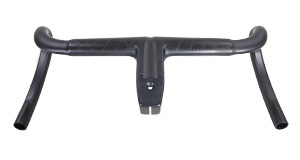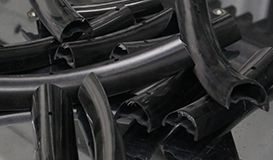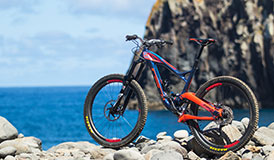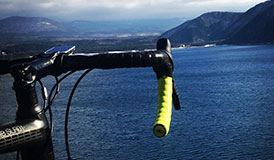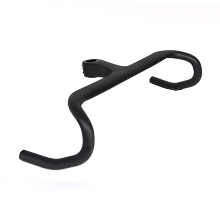Handlebars. They're an often overlooked but critical part of every bike setup. Your handlebar not only controls how your bike handles, they also serve as a mounting place for brake and shift levers, and dropper post remotes. They're also one of the main contact points between your body and your bike, so choosing the right bar is important. In this blog we're going to unpack some handlebar facts and set you up for success when it comes time to build out your next cockpit.
Handlebar Shapes
Handlebars come in a wide array of options. Today we'll focus on two major categories: drop bars and non-drop bars.


Drop Bars
Drop bars have traditionally been the choice for road, gravel and cyclocross bikes. They allow riders to take low, aerodynamic positions on the bike to gain and hold speed. Drop bars offer three alternative hand positions: the tops, the hoods, and the drops, to maximize comfort over long rides and provide ideal contact points for different riding scenarios. Drop bars are generally quite narrow, making it difficult to take precise turns.

Size Parameters
Measured center-to-center between the tops of the brake hoods, a drop bar's width ranges from 36cm to 46cm. A drop bar with a width roughly matched up to your shoulder width will provide the most comfort. A narrower drop bar offers aerodynamic benefits as it puts the rider in a tighter position. A wider drop bar results in a more stable ride quality and makes the bike easier to control.
Reach refers to the horizontal distance the bar extends forward before curving backward. Drop is the vertical distance from the highest point of the bar to the lowest point. Measured in degrees, flare represents the amount of outward slope from the top of the bar at the bend to the bar end. Traditional road handlebars have zero or a small flare, whereas most modern gravel-oriented bars come with a big flare.


Variations
Drop bars see three dominant variations: traditional, compact and ergonomic drop bars.
Featuring a long reach and a deep drop, traditional (or classic) drop bars have largely gone out of favor in recent years as many riders find it hard to use them effectively.
Compact drop bars have a short reach and a shallow drop, allowing for quick transition among different contact points and a smoother ride quality.
With an ergonomic shaping of the top and drop sections, ergonomic drop bars are designed to ensure maximum hand comfort in various hand positions for longer rides.

Non-drop Bars
Non-drop bars are popular among mountain bikes and other off-road cycles. They put the rider in a more upright and natural position, which requires less flexibility and is much more comfortable. These bars are usually wider to ensure maximum bike control but with only one hand position available, riders may experience discomfort over longer rides.
These bars measure their width between the bar ends and are usually between 580mm and 820mm in width. Generally speaking, XC riders prefer narrower handlebars, while enduro bikes, all mountain bikes and downhill bikes favor wider options. Mountain bike handlebars tend to grow progressively wider over the years as bike geometry has changed and handling has been prioritized.
Non-drop bars that rise from the center of the bar toward the grips are called riser bars. The vertical distance measured from the centre clamp area to the bar end is called the rise and normally ranges from 0mm to 40mm long. Flat bars have 0mm rise. A higher rise results in more weight over the back wheel, allowing the rider to lift the front wheel over obstacles, while a lower rise keeps the rider's weight farther forward for steep climbs and precise cornering.
A non-drop bar's upsweep or backsweep refers to the degree to which it sweeps up or back from the center line. The upsweep is typically around 5° and the backsweep usually ranges from 5° to 12°.


Handlebar Materials
The majority of handlebars available on the market today are made either from aluminium or carbon fiber. This choice is usually one of personal preference. Aluminium handlebars are popular thanks to their durability and reasonable price points while carbon handlebars are appreciated for their damping qualities and reduced weight.
Integrated Dropbars
Integrated dropbars incorporate the stem and handlebar into one single component. Here at Light Bicycle, we offer a full carbon integrated gravel dropbar on our website. Compared to the traditional two-piece combination, this integrated dropbar is much lighter, weighing only 325g. Carbon fiber runs continuously through the assembly for added strength and a 22.1° flare allows for stability and control through rough and steep terrain. Internal cable routing compatibility contributes to a clean cockpit.
Looking for a gravel-optimized integrated dropbar? This is the go-to option for you!
We hope this blog has been helpful. Handlebars and stems work hand in hand, so in the future we also plan to introduce some stem options. If you have any suggestions, please contact us (sales@lightbicycle.com). Your feedback is highly appreciated!
June 23rd, 2022 | Light Bicycle
Get in touch
Feel free to leave a comment if you have any questions or suggestions on our products or other issues.

Please leave your name here.
E-mail is required for further contact.
Please enter a message.
We use cookies for a better experience. Learn more.
Your Cookie Preferences
We use cookies to improve your experience on this website. You may choose which types of cookies to allow and change your preferences at any time. Disabling cookies may impact your experience on this website. You can learn more by viewing our Cookie Policy.
-
Cookies required to enable basic website functionality.
-
Cookies used to understand how the website is being used.
-
Cookies that are used to enhance the functionality of the website.
-
Cookies used to deliver advertising that is more relevant to your interests.
Aceept All Cookies
Save Preferences
Reject All Cookies
Save Preferences
Reject All Cookies
Accept All Cookies






